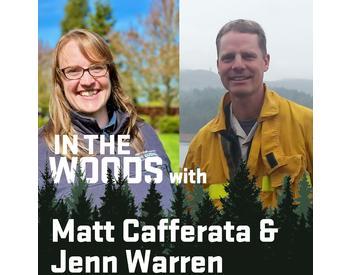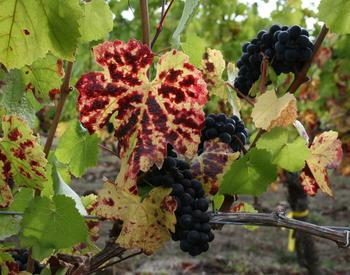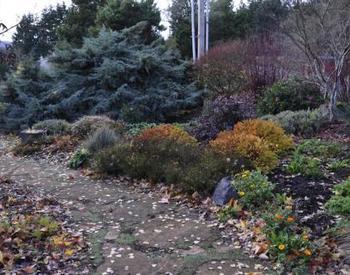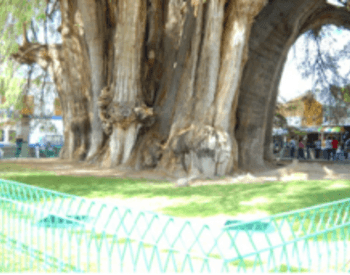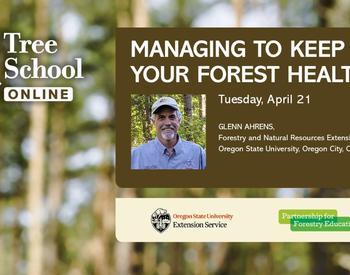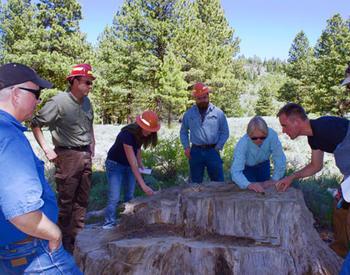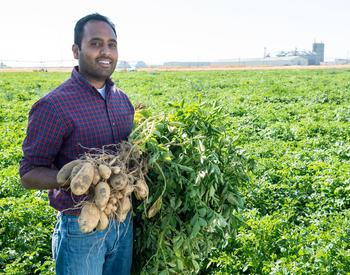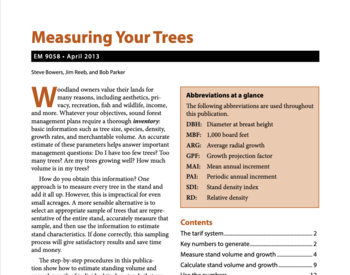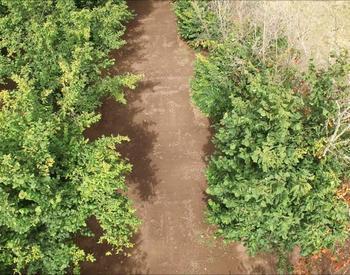Transcript
From the Oregon State University's extension service, you are listening to In the Woods with the forestry and natural resources program. This podcast aims to show the voices of researchers, land managers, and members of the public interested in telling the story of how woodlands provide more than just trees.
They provide interconnectedness that is essential to your daily life. Stick around to discover a new topic related to forests on each episode. Welcome back everyone to In the Woods podcast presented by the forestry and natural resource extension program at Oregon State University. I'm Jacob Putney, extension agent in Northeastern, Oregon, and your host for today's episode.
I'm very happy to be joined today by a current and former colleague. And more importantly, two friends, Dave Shaw and Gabby Ritokova. Dave is a forest health specialist with the forestry natural resource extension program, as well as a professor in the college of forestry at Oregon State. Gabby is formerly a senior research assistant at Oregon State and is now a forest pathologist at the Oregon Department of Forestry.
I had the privilege of working with both Dave and Gabby while I was a student. And I'm so glad we still get a chance to do so. So, both of you are brilliant forest pathologists and forest health experts. So, today we're gonna talk about a big one in Oregon, uh, Swiss needle cast. So, Dave Gabby, it's so great to see you both.
I feel like it's been way too long, so thank you both for joining us today. Thank you, Jake. It's good to be here. Yeah, thanks Jake. So, Dave we've, we've had you on the podcast before, so let's start with Gabby. Uh, Gabby, could you tell us a little bit about your background and what you've been working on recently?
How have you been enjoying your new role with ODF? Oh sure, um, I'm a state forest pathologist and part of a small forest health team at the Oregon Department of Forestry, as you mentioned. And since I've been on the job for less than a year, I'm still in a learning and training mode under lots of new projects that I'm working on.
For example, this spring, I undertook training to become an aerial observer. Um, generally we fly in a small airplane to monitor and identify declining or dying trees. And after the aerial survey, our forest health team conducts ground verification of some of these areas. I also provide pathology training to ODF field staff and foresters.
Um, overall I really like working with forest diseases and it has an added appeal that I can provide technical guidance to ODF foresters, but also landowner to meet their management goals. And Jake, as you mentioned, I just wanted to add that I worked with Dave very closely in the Swiss needle cast co-op at OSU for almost 10 years.
During that time, um, my work focused on establishing an extensive research in monitoring plot networks within the entire coast of Oregon and Southwest Washington. That's really cool you get to be an aerial observer. I always see the results from those surveys, but I've always thought it'd be so cool to be able to sit up in the plane and actually see 'em from the air.
Yes, not just a plane, but also a helicopter. Sometimes we fly in a helicopter and zoom on some areas that, uh, require more attention and more specific points. Yeah. Yeah. That's super cool. Um, Dave, how about you? What have you been up to recently?
Well, um, yeah, things are, uh, a little upset in Oregon right now with the, um, discovery of the Emerald ash borer up in Forest Grove.
And so to tell you the truth, we're spending a lot of our time in the response to that development. We're very worried about the health of our Oregon Ash and our urban ash, um, planting. So, things have really gotten kind of crazy with that, but I'm still, uh, working on Swiss needle cast, uh, and still collaborating with Gabby and others are members.
And so, yeah, I'm director of the Swiss needle cast co-op. And so this topic is, uh, uh, was quite happy to see we're uh, wanted to discuss with needle cast today.
Yeah, Swiss needle cast is a big one, but yeah, the, uh, Emerald ash borer has really taken the spotlight recently. On our last episode, Lauren talked to Christine Buhl and Dan Stark a little bit about that and what that might mean for the future of Oregon's Ash.
Yeah, I, um, heard that podcast. It was quite nicely done, and, um, yeah, we are really we're responding right now. We're we're not quite sure, you know, what the status is. Uh, we know that the there's a population in Forest Grove, but we don't know how far it's spread and whether it's into our native, uh, Ash dance yet.
So, there's still a lot of developments that we're waiting to hear about. So, things are quickly moving, but we don't know the, the overall situation quite yet.
Yeah. Yeah. Understandably and well, hopefully it doesn't get too worse, but to switch gears, to talk about one that's been around for a while and still destructive, let's talk about, uh, Swiss needle cast.
So, obviously we're not in Switzerland, so let's start with what Swiss needle cast is and how it got here.
Well, I can take this one. Well, you're right, Jake. There is nothing sweet about Swiss needle cast. Um, the disease was discovered in Douglas fir plantations in Switzerland in the mid 1920s. And the name has stuck.
Um, the disease is actually caused by a fungal pathogen, uh, called Nothophaeocryptopus gaeumannii, which was recently changed from Phaeocryptopus gaeumannii, and it is only present on Douglas fir. Um, basically it's a native disease and it has always been here. So, what we have is a native fungal pathogen that is found throughout the historical range of its only host, Douglas fir.
The symptoms include yellowing needles and decreased needle retention. Needle losses are generally worse towards the top of trees and among older, um, needle cohorts. I mean, those would be about two, three or four year old needles. And what this does, is it basically results in sparse crowns and because of the foliage loss, there is also reduced diameter, height and volume growth.
Dave, do you wanna add anything to that? Well, I just wanted to mention it's a fascinating fungus because, um, it appears that no Douglas fir is really immune from infection and the fungus, um, enters through the stomates of the current year foliage. So only after the foliage has been on the, on the tree a couple of months.
The fungus spores land on the, on the leaves during rainy periods and high humidity and enters the leaf. And then it appears to live in the leaf endophytically, without causing any harm to the tree, which is kind of unusual for most foliage diseases. But what happens is, uh, when the fungus fruits and produces spore producing bodies, um, those plug, the stomates, so, or the air pores on the underside of the leave, so that the tree, the disease is actually precipitated by the plugging of the air pores and, and carbon starvation of the leaf.
So, it's kind of unusual in that way. It has a very unusual, um, epidemiology and, uh, most other fungal diseases will actually, you know, decompose cells and, uh, cause necrosis of the leaf.
But this is a sort of a secondary pathogen in that sense, although, although it is a, a forced pathogen, but, um, it doesn't directly kill the leaf except when it plugs the air pores. So, it's, it's unusual in that way.
And all of this happens during springtime and it coincides with, um, bud break, when new foliage begins to grow and elongates. And only new needles are susceptible to this infection.
Right... It's really. And the, oh, go ahead, Jake. No, no, I was just gonna say that's really interesting. That only new needles are susceptible. Right. So, the second, third, four year old needles do not seem to be susceptible to additional infection, new infections. Um, it's just the current, year foliage, so that, that, that also affects control.
So, when you, you know, when you, if if like some nursery managers may spray, uh, fungicides to protect the leaf from infection, but they're only, they're only protecting the current year foliage. And so as soon as you stop, the next year's foliage would then subsequently get infected. So, it's a, it's an unusual fungus that way.
So, it's only on Douglas fir, and you mentioned it was first discovered in Switzerland, but does it affect different Douglas firs in different parts of the across Oregon or across the world?
Go ahead, Gabby. All Douglas fir is susceptible and studies have shown that certain climate factors aid the germination and development of Swiss needle cast. Um, successful germination needs spring moisture.
And that's why coastal areas have more disease. Once they, meaning spores, have successfully germinated. The warmer winter temperatures seem to aid the development of these fruiting bodies. And not many people think of coastal area as being warm in the winter, but it's low elevation and mild maritime temperatures are pretty low or warm compared to interior higher elevation environments.
And that's one of the reasons why we see it mostly on the coast. Yeah, and it's, it is, uh, Douglas fir uh, only is thought to be susceptible. However, like big cone Douglas fir down in California is also thought to get it. And so it is assumed that other Pseudotsuga species may be susceptible. And we know that big cone Douglas fir, for example, uh, I think that's, Pseudotsuga macrocarpa.
But anyway, I apologize if I got that scientific name wrong, but, uh, that tree is susceptible, but it's just Douglas fir it's not on spruce or fir or abies, I mean, so when it, what we think happened in Switzerland was they got their seedlings from the United States. And when we sent seedlings to Europe of Douglas fir, in the 1920s, that's how it was introduced to Switzerland and Germany at the time.
And now it's pretty ubiquitous throughout Europe, wherever they grow Douglas fir. And it, um, causes disease, you know, similar in Oregon, there's certain geographic areas, which seem to be more susceptible to the disease than others.
You mentioned, uh, it's endemic. So, Douglas fir over here on like the east side, the inland, uh, variety could have Swiss needle cast, but it wouldn't be experiencing any of the, uh, severe effects, like over on the coast?
Yeah, and that's controlled by climate. So, we think that the dry spring and summer weather, uh, that you get over on the east side, um, we typically only see Swiss needle cast in really in micro sites. You know, uh, next to streams or bodies of water or those kind of things over on the east side.
However, when you take an east side Douglas fir and you bring it over to the west side. It's way more susceptible to Swiss needle cast than our local, um, local seed sources. So, seed source does matter, and it, uh, when you move seed from a dryer region to a wetter region, you, we tend to see increase Swiss needle cast.
And when you move a seed from a higher elevation to a lower elevation, we see increased Swiss needle cast. So, it's, it is kind of, even though the disease is, is worse along the coast. The, uh, the coastal forms of Douglas fir are, um, much, you know, are much more, uh, tolerant of the disease than the inland varieties.
I want to echo that. Definitely moving seed around is not a good idea. If it's a non coastal source, it probably won't do while on the coast. So, do not move it there.
Yeah, that's really interesting. So, based on the severity of the infection then, and kind of the extent of the needle loss, what kind of impacts to tree or forest growth could you expect from this disease?
So, first, um, uninfected Doug fir trees in the coast range typically have about three to four years of foliage. The most infected stands have about one year of foliage. So, as foliage retention of infected trees declines, growth losses increase. It's not quite a linear relationship, but it's pretty close.
So, diameter growth is especially affected and in the most heavily infected areas, volume growth loss is up to 50%. Um, there were some estimates from the most recent measurements of the plot network that I mentioned earlier, suggest that maximum growth losses aren't quite as high as they were during the earlier period.
And I believe those studies were done in the nineties, correct me if I'm wrong, Dave. And that's about 35% versus 50% loss. But that is probably because the worst performing stands have been liquidated since that earlier period and replanted to hemlock. Yeah, so we, we normally, um, don't start getting concerned about, um, growth losses until we're down around two and a half to two years of foliage retention.
And that's usually we're seeing, you know, 20 to 25% growth losses at those levels. Uh, just to mention, um, outright mortality caused by Swiss needle cast is pretty rare and it's pretty localized on the coast. And what we, what we really see with Swiss needle cast is growth losses. And it's those ubiquitous growth losses across the range of Douglas fir, you know, across several million acres of Douglas fir, they really add up.
And, um, so, but generally we don't see outright mortality caused by this fungus. And when we do see mortality, we say that it's a complex interaction of biotic and abiotic factors. I use that line all the time. Yes, the last time we saw some, some mortality, we associated it with dryer than normal periods along the coast.
So, that these trees were very carbon starved becuase they didn't have any reserves, uh, due to the disease. And then when the drought hit they were sort of double whammied and we saw tree mortality associated with that combination.
Um, so if I was someone that, uh, owned a tree farm or, uh, a forest over on the, the coast, especially, um, how would I be able to tell how bad or how severe an infection is of Swiss needle cast? I mean, sparse crowns, needle retention, and things like that, but how would I really assess that severity?
Well, that it, yeah, go ahead, Gabby if you wanna take a swing at that, um, or... Well, I will and you can fill me in. Okay. Um, so what we do is we recommend looking for the symptoms that you described and we described earlier, the yellowing of the needles, thin crowns, any older needles, say the two, three or four year old needles are gone, then you should definitely be suspicious.
So, what you do is you take a needle, you observe the underside of needles, preferably with a hand lens and look for small black dots on the underside, which are the fruiting bodies that we've been describing and they're blocking the stomates.
If people are not sure what to look for, we have photos on the Swiss needle cast co-ops website. Right, and we have, um, also some other literature, there's a forest insect and disease leaflet out on Swiss needle cast, which has some really good photos of some other things.
So, we definitely have resources online to examine the fungus, but so if your forest plantation has less than three years, you know, it's down around two years or less of foliage retention, then we do suggest you follow up with looking under the needles and determining whether or not you confirm that there is actually Swiss needle cast on the two and three year old needles.
If you see that, then you can be pretty much assured that the growth losses are, are a result of Swiss needle cast, but you really need to confirm the fungus is present on the needles, particularly on the two and three year old, uh, needles, because that's where they really begin to affect needle, uh, longevity.
Then we usually, uh, ask to follow up with some, because Swiss needle cast is, um, very nuanced to manage and it's very, uh, you know, determining that that's actual that you're actually suffering growth losses in your stand can be kind of tricky. So, we do have a couple of different methods to get at that. Um, one is doing a cruise of your stand and including increment coring trees and looking at five year growth rates.
And then, uh, comparing that to what would be the predictions of growth rates. Uh, we do have a Oregon Department of Forestry and Doug Mainwaring at the Center for Intensive Planted Silviculture, uh, did develop a tool that can be used, um, where you can plug data in and that's available on our website also.
Um, basically what that tool does is it takes your, your stand data and then runs a standard growth and yield model. And then it takes the data that you get from, from what the actual stand is doing and compares that to what the normal growth rate should be. And then that for a large landowner we do recommend that approach to really quantify whether or not you are deviating from what was predicted or not.
For a small landowner, it can be a little, um, more difficult to actually understand those kind of models and that kind of thing. So, there we just wanna see, you know, are you below two years of needle retention?
And is there these fruiting bodies, we call them pseudothecia, on the underside of the needles. And then, um, does your, um, growth rates, your five year growth rates seem to be much lower than what you would sense they would be? So, there's kind of a intensive, quantified approach that can be done. Or for the landowner, maybe a less intensive, quantified approach, but still gets at whether or not you think you're really losing growth due to this fungus.
It, it can be kind of tricky to be honest. Yeah, I've seen, I've seen those tools on there. Sorry, Gabby, did you have something? Well, I was going to say something about those tools and the tools, the stand stand growth assessment tool on the website is available to anyone. And so is the growth model, ORGANON, but truthfully the, the tool is a little bit clunky.
So, we still have to sit down with our growth and yield guy, with Doug, to learn how to use it ourselves. Or a Jake you could probably teach us also.
I haven't looked at it in a while, but I do remember that tool being available, but, um, we'll be sure of links some of those resources for, so folks can check them out if they're interested.
But, um, speaking of, of landowners and management, what have landowners been doing to, to mitigate the impacts of Swiss needle cast? Um, thinking between small and large landowners too, uh, are the strategies consistent? Are they different between different, different types of landowners?
Well, I'm not quite sure whether they're different or whether they're similar, but in areas where, uh, Swiss needle cast is especially bad landowners plant, non-susceptible species, and it's primarily Western hemlock.
Um, and then there is a Northwest Tree Improvement co-op that has been working to identify tolerant families. And those families are prioritized in areas where there is more disease pressure. But that said, it is considered a mistake to plant such families where the disease pressure is high because they may be tolerant, but they're not that tolerant.
So, some landowners will plant mixes, um, increasing amount of Douglas fir with hemlock as they move inland from the coast, until there are in zones where disease pressure is so low that they're comfortable with, uh, pure Doug fir stands.
Yeah, that's it. The, those two approaches, I think, are it, you know, using, uh, in the highest severity areas, moving away from Douglas fir, and then as you begin to plant Douglas fir, um, relying on improved stock that is more tolerant.
There's been breeding going on for a while now. And so there is improved stock along the coast that you can use, but definitely some places are just too severe to really rely on Douglas fir. And so, you know, when you look at the coast range, for example, there's all these gradients of, of infection that, that infection changes with elevation and distance from the coast.
And so it's really, uh, the land managers really use a nuanced type of approach to, um, manage Douglas fir. And it's, you've got sort of local understanding of how bad it was in your surrounding stands or, or how bad it was in stands that had been harvested. And then, so to understand what the local environment might be, right.
And then evaluating your stand, um, and then deciding at the time of planting, whether you want to go with Douglass fir again, or whether you'd prefer a mixed species or a, or a completely alternative species. And, and then the tree improvement, we're continuing the Northwest Tree Improvement co-op is continuing to work on that.
So, also something that is, you know, we're hoping has improved, but, but those folks say, you know, don't plant this improved stock in these really hammered areas. Uh, but to be honest on the landscape, the landowners, uh, vary in their objectives and in their, you know, in inherent biases. And there's a major bias towards Douglas fir because it is so much more valuable than hemlock.
And it, you know, it's easier to grow. It's easier to get seed, and those kind of things. So, there tends to be a sort of everybody prefers Douglas fir, unless they can't use Douglas fir. And some people continue to plant Douglas fir and hope for the best or hope the improved stock will help them. But it, so it really seems to vary by landowner, uh, in terms of what specific plants are, are really in place.
We also do have suggestions for thinning and, um, various other intermediate silvicultural treatments. And we have published a, uh, guide to, uh, silvicultural decision making for Swiss needle cast, which is available on our website. If you just Google Swiss needle cast co-op, you'll get to our website quite quickly.
And that decision guide is on our website and it's also available through extension publications. And, uh, if you are getting into the silviculture of, of needle cast, we would suggest getting a copy of that decision making guide, and it helps, uh, provide this framework we've been talking about. And I also recommend communicating with professionals, communicating with us.
Um, as I mentioned, this is a native disease and it's pretty much everywhere where Douglas fir is grown. Having said that this is a disease that we have to live with. There is no fix to it. So we basically have to learn how to manage it, manage the stands with Swiss needle cast presence.
And in areas that appear to have problem with very high disease pressure, just like Dave mentioned, don't plant Doug fir. And just like he mentioned, we have seen stands in badly infected areas that have been harvested and they have been replanted with Douglas fir. So, clearly the hazards of the disease are not universally understood. Right, uh, there's also another anomaly with Doug.
I mean, just because you find Swiss needle cast in the stand. Doesn't necessarily mean it's causing growth, declines. So, that's why we emphasize needle retention. How many years of needle retention are you seeing? And these kind of things to sort of supplement that idea. But you can have Swiss needle cast present and still not have growth declines.
So, it's unusual, you know, again, for that reason, it's, um, it depends on, uh, when these pseudothecia these share are being produced. And if they're being produced on one, two and three year old needles, then you're liable to be seeing growth losses. But if you're only seeing them seeing the pseudothecia on like three, four and five year old needles, then it's probably not really causing growth losses.
So, it's, it's a very nuanced disease to manage, uh, which is one of the sort of crazy things about Swiss needle cast.
Yeah, I was just thinking of a, a question and, um, Gabby, I think you answered it a little bit, but say a, a landowner's objective is to manage on even aged rotations of Douglas fir, and this Douglas fir stand was heavily infected prior to harvest and replanting. Is it a safe bet that that next stand would be heavily infected eventually too? Or does that vary?
I would think so. Yes, I think so. If you had a really heavily infected stand and you replant, um, Douglas fir it's, it's likely to be infected again quite, quite quickly. We normally, we normally don't see a lot of the real impacts until the trees are reaching like 6, 8, 10, years old and that, you know, between 10 and 25 to 30 years old is where we see, you know, a lot of the significant impacts on, on tree growth and stand development.
But yeah, we definitely think that that's the case. If you have a really heavily impacted stand, you should seriously consider alternatives in your next rotation.
Those are the fun ones to climb, to, uh, measure needle attention. Yeah. True. Those, uh, yeah, I have definitely done a fair amount of that.
Let's um, let's dive into the research side of it. I mean we mentioned it in the Swiss needle cast cooperative a lot, but what's, what's kind of the latest on the co-op and the research that they're, they're working on. Yeah, so, uh, oh, go ahead, Gabby if you'd like to. I was just going to say that Dave is the one that's been around for a long time, so he can give you a little bit of history on the co-op. Yeah, that'd be great.
As to what has been addressed and we've investigated, you know, the biology of the disease, understanding of the epidemiology, the effects on growth and yields, just like we talked about. Dave mentioned the effect of silvicultrual treatments and infected stands. And that includes thinning, fertilization, um, mixing species, genetics, which is search for tolerant or resistant families.
Is there anything else that I'm not mentioning, fungicides? Yeah, that a lot of that's it. And again, a lot of that is in our decision making guide. Um, the Swiss needle cast, um, you know, as we said back, when it was first described in Switzerland, in the twenties and thirties, they looked in North America and they felt like Swiss needle cast was a native ubiquitous fungus that had no effect on tree growth in the U.S. at that time.
As the Christmas tree, uh, industry merged in Washington and Oregon in the 1970s and 80s. Swiss needle cast became sort of more important in research and that kind of thing because of its impact on Christmas tree plantations. It wasn't until the late, excuse me the late eighties and then in the 1990s, when the disease really merged in plantations of coastal Oregon, where it was really first described, particularly around the Tillamook area.
And one of the theories that we're currently working on now is that, uh, the, the epidemiology really focused on two factors. One is the rainfall during the spore dispersal period, which occurs from May until August. So, whenever you get rainfall and high humidity and dew and wetness, uh, on your foliage during that summer, or late spring, early summer period.
That's a high hazard for, you know, spore dispersal and good infection of needles. The other factor that's appears to be really important is winter temperature. And that's why we think that the disease is, uh, most important at lower elevations near the coast, because it's so mild.
And we think that during the eighties and nineties, winter temperature was was significantly increasing along the coast. And that winter temperature may have been a factor in the emergence of the disease in the eighties and nineties. The co-op started in 1996. It was, uh, really emerged out of a grassroot sort of tree growers were really concerned with what they were seeing, and they wanted the Oregon State University to form a co-op.
So, uh, Oregon State did do that. And Greg Filip was the first director of the co-op and he managed the co-op for another decade or so. And, um, then I came in at about 2005 and at that time, the, the folks, uh, Greg Filip, uh, Everett Hansen, uh, Jeff Stone, Dan Manter, uh, and others were really involved with us, figuring out the epidemiology. Figuring out, you know, which you know, that it was in fact, a Nothophaeocryptopus gaeumannii causing the disease.
And then since the, the time that we have, uh, come on since I, I started in 2005, the co-op still, um, maintained, but we've really, we shifted to silviculture and, um, management. And then as Gabby had said, right now, our main focus is on our plot network. So, we have a series of plots from the California border all the way up into southwest Washington and, uh, that plot network, um, within about 35 miles of the coast.
And then we have a monitoring plot network also in along the western slope of the cascades. Particularly below about 3000 feet elevation where the disease seems to be most important in our high humidity valley bottoms and areas along the lower, lower elevations of the western cascades. And, um, we're using those, uh, plot networks as sort of the foundation of understanding epidemiology.
And, um, relationships with other diseases and we're improving our models, uh, in terms of the distribution of the disease, where the impacts are greatest. So, you can go to our website, or we have an article in Journal of Forestry, which has some of those maps and shows where needle retention is lowest and where disease severity is highest and that kind of thing.
And so we do have models. Those models in terms of a landowner, those are really informative models for, for landowners, because it gives them some qualitative information about where the disease might be most influential. However, we still suggest that any landowner evaluate their stands on a stand by stand basis because we see so much variation, uh, within the coast range that we can't explain that we think that you really need to make your decisions based on the stand that you're actually managing instead of some kind of model or a map that shows where the disease might be highest.
Um, and then in the future, we're really, uh, looking to, um, get into the whole microbiome and all these other fungi and other agents that are on the leaves and in the tree. In the leaves and on the leaves and how they interact with Swiss needle cast. And whether there may be some opportunities to use some of these other fungi that might be antagonistic to Swiss needle cast in the control.
So, um, we're but we're still improving our modeling, our growth and yield modeling and improving our epidemiology models to, you know, firther understand the disease. Gabby, is there anything else there that you were thinking about? No, Dave, I think you covered it pretty well. Um, past and future research as well, even though you're retiring very soon, you're going to pass the baton over.
Oh man, the secret's out. Yeah, uh, so it looks like Jared LeBoldus our, uh, forest pathologist, uh, who has a shared position in botany and plant pathology and, uh, college of forestry of forest engineering resources and management department. It looks like he'll be taking over and, um, taking over directorship at the co-op and in January of next year.
Yeah, we're, we're hoping for continuity, uh, yeah, in this effort because it's still, you know, affecting, uh, the disease hasn't is still influential in Washington state. And it's recently emerged in Southwest British Columbia and has become one of the major diseases of Douglas fir in Southwest British Columbia. Which, so, you know, the disease is still very important in the region and we're still sort of working on ways to manage it.
So, thinking about all the work that the Swiss needle cast cooperative has done and, uh, your plot network. Do you have any insight to what the future's gonna hold for Swiss needle cast, especially with things like climate change? Is it gonna get worse? I think it's going to get worse. That's what I'm thinking.
You know, temperatures are getting warmer and, uh, though the effects of climate change on moisture may be less predictable. It's difficult to imagine that moisture near the coast will decrease. And in terms of Swiss needle cast, moisture includes mist, fog, rain and general humidity. Um, the most recent work has found that foliage retention is lower, where you have increased spring precipitation and higher summer relative humidity.
Just like Dave mentioned that earlier. And if climate change results and increased atmospheric moisture, whether precipitation or humidity, that will increase successful fungal germination and successful establishment of the disease. That's my opinion. I think it is going to get worse. Yeah. Yeah. The, the many of the predictions are that, you know, given that, you know, we have this sort of two things that we're thinking about, like Gabby was saying it's winter temperature and our seasonal precipitation.
And those two things together, but most models are saying that, that it's highly likely that Swiss needle cast will increase at higher elevations because of warming winter temperatures. And, but that will have a lot to do with whether or not, um, we get, uh, you know, this precipitation in particularly May, June and July. For example, uh, this year looks like it was a absolutely wonderful Swiss needle cast year.
We had mild winter temperatures and, um, and it rained right on through, into mid-July. And that kind of, that, that rainfall through May, June and July was probably really helpful for spore dispersal and Swiss needle cast. So, we're anticipating in the following years that we may see the, the intensification of Swiss needle cast, um, occurring, just because of this, you know, weather we've been having, even though we were, seemed like we were in a drought, as long as you get this rainfall during these, um, May June, July into August, you can get increases in Swiss needle cast, even during a drought.
You know, with, with these rainfall events that can happen in the summer. Those are perfect environmental conditions. Yeah. Well, it sounds like the co-op's gonna have no shortage of things to do then looking forward. Um, I wanna make sure I don't miss anything here. So, do we have any parting thoughts on Swiss needle cast or the co-op or anything folks could do to, to try to mitigate impacts or monitor these impacts?
Yeah, I would say just, um, you know, in terms of, um, monitoring your stands, you know, just keeping in consideration, uh, foliage retention and color, and, you know, the presence of Swiss needle cast in your stands.
But as we said, just because you can find Swiss needle cast doesn't mean it's causing growth declines. So, it's really a nuanced management and dependent on where you are geographically. And, um, so I would just say, you know, continue paying attention. A lot of the, the, some of the things we haven't mentioned is there are different lineages of this fungus sort of similar to the whole COVID thing, where you get the BA five and the Omicron and the various other lineages.
We have, uh, right now, I think three known lineages, uh, for Swiss needle cast. One of 'em is really restricted to the coast. Another is very ubiquitous. And then a third is restricted to the inland areas of Northern Idaho, Montana and British Columbia.
And we don't really understand the, uh, implications of these different lineages of Swiss needle cast. They're very difficult to work with and we don't at this time, we don't think there's a lot of difference in pathogenicity, but some recent research from British Columbia suggested that some of these, uh, one of the lineages, the more ubiquitous one was, uh, tolerant of higher temperatures. And that this was the one that they were suggesting might be, you know, really most important in the future because there's this variation around the temperature, um, optimal temperatures for growth and that kind of thing.
So, um, yeah, there are sort of various sort of aspects of swiss needle cast that we didn't really talk about today that are, you know, being studied. And the folks up in British Columbia have really got into research on Swiss needle cast.
So, we anticipate a bunch of papers coming out of their work. And, um, it should be interesting to see how their research aligns with our research and that kind of thing. So, we're really thrilled that the Canadians have got into this and that they're investing into research dollars, you know, into Swiss needle cast right now.
And, uh, we collaborate pretty strongly with them and the folks in Washington. So, uh, the last thing I do wanna mention though, is it's the, the one funny thing about Swiss needle cast is it doesn't appear to be hugely important in California. So, we get down to Southern Oregon and, and our aerial surveys that we've done in Northern California.
We haven't seen much Swiss needle cast at all. And, um, we don't understand really why. Uh, it may be because, uh, spring or it's summer, late spring and summer rainfall is very different down there than it is here. Or, that they prefer redwood. And, uh, they grow Redwood in their really high susceptible sites that, you know, the coastal fog sites.
Whereas we grow Douglas fir in our coastal fog sites. And that might be one of the differences also, but we don't, we don't know for sure. Well, I know Swiss cast is a major forest health issue in Douglas fir, especially over on the coast. So, thank you both for sharing your expertise with us today. Uh, if any questions came up while you're listening, or if you'd like to learn more, please drop us a comment or send us a message on our website.
And as usual to conclude our episode, we have to end with our lightning round.
So, we have a few final questions here and let's start with Gabby. So, Gabby, first question is what is your favorite tree? Uh, I have to think about this one. Um, it is going to be a little unusual. It's Tilia Cordata, it's a Linden tree. I grew up in central Europe where linden is native. It's beautiful. Um, I love the smell of linden tree in the summer.
It's desiduous tree with heart shaped leaves and has beautiful, tiny flowers that bloom in June. Um, it can be tall and it generally has a large canopy, which means that, um, which makes these linden trees great street trees providing shade in the summer. They're very popular in my part of the world. And one of the things that I love about is in late spring and early summer, linden blooms, um, and the tiny flower flowers covered the entire canopy.
And they're very fragrant, very nice. You can smell them from a mile away. They are also insect pollinated and provide food for bees, which means that we also get linden honey. Very nice. And when I was growing up, every summer we would go and pick the flowers and dry them for tea.
So, I think there is a little bit of a nostalgic feeling for me and, um, a soft spot for linden trees. Yeah, that is an interesting one. I, I think that's our first, uh, European tree species, or at least native European tree species. There's so many cool trees.
Our next question is what is the most interesting thing you bring with you in the field, whether in your cruising vest or field kit, um? Oh, Jake, I have to go with the dog. Oh, the dog. Of course. I love taking my dog to the field, but I also bring a hatchet and a hand lens, um, and a Ziploc bag or a few Ziploc bags to collect specimen as needed.
Yeah, after working with you and Dave, I, uh, I, I can't leave without a hand lens now. Yeah. The hatchet is always nice too, to see what kind of bugs are underneath the bark. Alright, Dave, let's move on to you. What is your favorite tree? I don't remember what you said last time. So, uh, you could pick a different one this time.
It, it was, uh. Well, my favorite tree, it is kind of a, um, maybe a it's Douglas fir. And, uh, I really like Douglas fir, um, it's an amazing tree grows to be so old. I, you know, I love being in any age class of Douglas fir, you know, particularly like, you know, being in the old growth Douglas fir with the 500 year old trees and such, and it's just an amazing, amazing species. It's the best two by four in the world.
Um, so it's just a great tree. So, I don't know. It might be sort of too common, but it's, it's definitely my favorite tree. It is a good one. Um, besides a hand lens, what is the most interesting thing you take with you in the field? Well, probably, uh, you know, it's spin on the axis, the Pulaski, of course.
And so the Pulaski is what a lot of pathologists, um, carry with them because it's the all around tool for digging roots and chopping the bark. And you can get pretty much any part of the tree with a Pulaski. So, I'd say the Pulaski is probably the most, uh, interesting tool I carry. Bridging the gap between fire and forest health.
Yeah, exactly. All right, I know we mentioned a bunch of different resources today, too, from the Swiss needle cast cooperative, but is there any we missed? I know we had the silviculture guide, the co-op, the growth model for looking at growth impacts.
Yeah, I'd say the, uh, our webpage is probably good, but I, um, we did recently, uh, publish a, a nice synthesis paper in Journal of Forestry.
It's, uh, let's see, it was, um, if you it's an open access article, so it's available to everybody. If you Google, um, Journal of Forestry, Persistence of Swiss Needle Cast Outbreak, or, or Journal of Forestry, uh, Swiss needle cast. I think you'll get taken to this article. It synthesizes pretty much, um, you know what we've learned about Swiss needle cast and some of the new things we've learned, uh, discusses climate change, and it discusses some of the other foliage diseases of Douglas fir.
That have emerged over the last couple of decades also. So, uh, that's probably another good resource if you're interested in, um, you know, digging deeper and getting into, you know, some of what's been going on with Swiss needle cast, but our website always to go. Go ahead, Gabby. Yeah, I was going to say that the SNCC website has a ton of material and including the publication that Dave mentioned, it's on there.
Okay. And it's all free. So, there are links to scientific publications. Annual reports are also available on the website as well as our contact information. So, you can always reach out to Dave or myself. And one more thing that I would like to recommend is the Oregon Department of Forestry website. Ah, it has a, a forest health web, uh, page as well, and it contains latest news, um, you know, description of the forest health program, fact sheets and information about different insects, diseases, invasives, et cetera.
It's a great resource for anyone to look at. Yeah, well I'm sure to get those linked, uh, on this episode's page as well. Okay, yeah, and the, the U.S. Forest Service Forest Health Protection also has a really amazing website that I think compliments the ODF one. So, that's also another really good link, uh, region six forest health protection.
Yeah, we'll get all those linked for sure. Okay. Yes, and there is one more thing. We have the field guide to the common diseases and insect pests of Oregon and Washington conifers. That's one of the things that Dave and I always travel to the field with. Right, Dave? Right. We have that book with us.
I never leave home without of either. I have both that one and the forest service one. Great. All right, well, Dave, Gabby, so very good to see you both. We need to get together one of these days soon, whether over on the west side or, uh, over here on the east, but thank you so much for joining us today.
Um, Gabby, we'll have to have you on again because there's definitely no shortage of forest health issues in the state. And Dave you're, you're kind of a regular now and you're a wealth of knowledge. So, I'm sure you have plenty more to share with us as. So lastly, this concludes another episode of In the Woods.
Thank you all so much for listening. Don't forget to subscribe and we'll see you all next time. Bye everyone. Bye. Thank you, Jake. Thanks Jake.
Thank you so much for listening. Show notes with links mentioned on each episode are available on our website inthewoodspodcast.com. We would love to hear from you, visit the tell us what you think tab on our website to leave us a comment, suggest just a guest or topic, or ask a question that can be featured in a future episode. And, also, give us your feedback by filling out our survey.
In the Woods was created by Lauren Grand, Jacob Putney, Carrie Berger, Jason O'Brien and Stephen Fitzgerald, who are all members of the Oregon State University Forestry and Natural Resources Extension team. Episodes are edited and produced by Kellan Soriano. Music for In the Woods was composed by Jeffrey Hino and graphic design was created by Christina Friehauf.
We hope you enjoyed the episode and we can't wait to talk to you again next month, until then what's in your woods?
In this episode, Jacob Putney invites Dave Shaw and Gabriela Ritokova on the podcast to discuss Swiss Needle Cast's impact on Douglas fir populations. Dave Shaw is an OSU extension forest health specialist and Gabriela Ritokova is an ODF forest pathologist.

